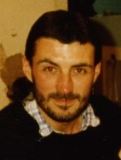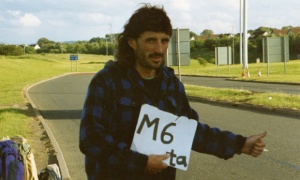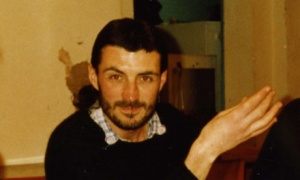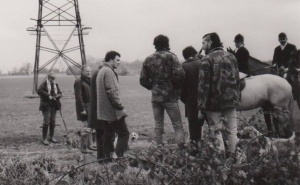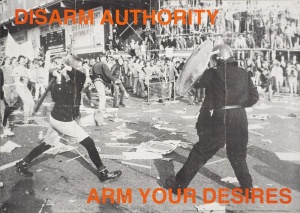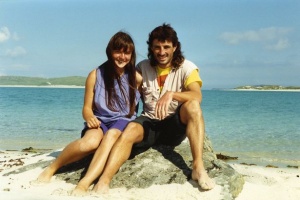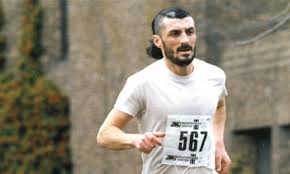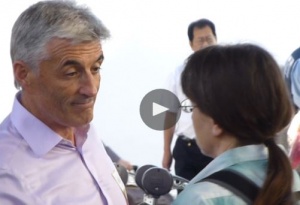John Dines
This article is part of the Undercover Research Portal at Powerbase - investigating corporate and police spying on activists
Please Note, as of 2025, the Undercover Research Group is now publishing new material on our new website: *spycopsresearch.info*
++++This profile was last updated in 2015++++ John Dines was an undercover officer in the Special Demonstration Squad between 1987 and 1991, disappearing early 1992. He infiltrated a range of groups and campaigns, mainly in North London, using the alias ‘John Barker’. During his time undercover, Dines had a two year relationship with Helen Steel. His abrupt vanishing from her life led to a 19 year search for the truth. In 1994, she found out that he had used the identity of a child that had died at a young age. In 2003, that he had been a married police officer and finally, in late 2010, Helen got the confirmation that Dines had been an undercover officer. Helen brought a court case against the police with seven other women who were also deceived into relationships with undercover police officers. This eventually resulted in a settlement and an unreserved apology in November 2015. The Metropolitan police acknowledged that the relationships amounted to a violation of the women's human rights, but still refused to confirm or deny that Dines had been a police officer.[1] Four months later Helen confronted Dines in Australia, after she found out he worked at the Australian Graduate School of Policing & Security as course director of a training programme for Indian Police officers, which included targeting left wing groups.[2] Note! This is a preliminary profile, we have not spoken to a lot of people yet, do get in touch if you have more detail. Also see:
Background
John Dines was born in 1955. Having joined the Metropolitan Police Service, he was selected by the Special Demonstration Squad to infiltrate groups in North London. Like most such officers, he was already married. Unusually, he was a sergeant when he joined the SDS.[3] [4] In 1994, just two years after his undercover tour of duty had ended, Dines left the police on a pension to compensate for his ill-health. He later went to New Zealand, where his in-laws lived.[5]
Cover Story and Personality
For his identity undercover, Dines took the identity of a deceased child – Philip John Barker, who had died of leukaemia at the age of 8 in 1968. As with his predecessor Bob Lambert, Dines used the middle name for his cover, a trick the SDS thought would make it initially harder for activists to track them down.[6]
He grew his hair long and the sides of his head were shaved completely, with a longer tail down the back of his head in the mullet style which was fairly popular in the 80's. He was well built, muscular and fit. Campaigners within London Greenpeace liked him as a member of the group. One activist recalls Dines as ‘easy to get along with’, although he did not exude the same ‘air of confidence’ as Lambert. Due to a slight accent he acquired the nickname 'New Zealand John; he claimed he had moved to New Zealand as a teenager. In fact he probably picked up the twang from his wife who was from New Zealand. His legend included a past as a campaigner against apartheid, including an arrest for assaulting a police officer during a protest against a tour by the South African rugby team in New Zealand.[7][8]
For some people, Dines’ undercover reputation was one of a tough activist not shying away from a bit of action on the streets. Paul Lewis and Rob Evans in their book Undercover cited an anecdote to illustrate this: Handing out leaflets criticising a right-wing Christian preacher in Wembley Stadium, he once punched a random punter who was uttering racist insults. The victim crashed to the ground and Dines told his fellow activists that he ‘hated fascists’.[7] This is probably why, within the SDS, he gained the nickname ‘Sergeant Yob’.[7][9]
One active anarchist the 1980s and 1990s based in Leeds, knew Dines from visits to London where he stayed with other activists. He recalls that at one point Dines described how to create a false identity using the name of a deceased child. This is quite significant knowing that the undercover based their legends on the identities of dead children.[10]
Housing situation
In the early part of his mission, John Dines lived in at least two squats in Hackney, north London for months on end. He would not go back to his own flat, like other SDS-ers would, not least at the start of their time in the field.[4]
- 1987 Camper van. Dines claimed to have lived in a camper van parked near Waterloo on the Southbank when he first came to the UK after growing up in New Zealand. He said all his stuff was stolen from it - probably to explain away his lack of personal possessions. Dines also said that he lived for a while in a flat at 256/258 Brixton Road, SW9. He is believed to have used an address in Wembley for a time, before he came to North London.[11]
- 1988/1989 John lived in a squat at 73 Dunsmure Road N16. This was near the extensively squatted Holmleigh Road Estate.[12]
- He also lived for a while in the Lee House squatted social centre in Rectory Road, N16.
- February 1990 (approx) Rented a flat at Castlewood Road, N16. Helen and others helped him move in shortly before he announced he had to go to New Zealand for his mother's funeral.
- May 1990 Burgoyne Road, Harringay. Dines rented a bedsit near Helen, she helped him decorate it and spent a lot of her time round there with him.[13].
- December 1990 - December 1991 Tottenham, near Seven Sisters. John and Helen rented a flat together and shared this home for a year.[13] The house backed on to the family of Winston Silcott, who were campaigning at this time for his conviction to be overturned after he and others were framed by the police for the death of PC Blakelock at the Broadwater Farm riots in 1985 (see below).[14]
- December 1991 Helen and John moved out of the Tottenham flat to a caravan on a smallholding in Yorkshire. However, Dines left the following day for a short break in France, and then told Helen he had secured work on the Channel Tunnel, so he never lived at the address in Yorkshire. In hindsight this was part of his exit strategy (see below).
Vehicles
Like many other undercovers, Dines had a van and often offered to drive people home from meetings and to demonstrations. In hindsight this was an easy way to find out where activists lived. Friends remember a number of vehicles over the years, including a light blue minibus type vehicle, an estate car and a white transit van. Some recall his van being used for arranging building materials for Lee House and that on one occasion he made a round trip to Cambridge at night, to return with a load of stolen bikes.[8]
Work
In early 1990 John said he worked for a company called Kingswood Kitchens. Later that year, he said he was working on construction sites, employed by a company called Construction and Technical Services Ltd based in Ware, Hertsfordshire. He claimed to have been working at various sites including the Mirror print works in Oldham (during 1990-91), the Channel Tunnel from Dec 1991 for a couple of months, and on road building near Tring shortly before his final disappearance in March 1992.[11]
Political activities
This is not a comprehensive list of the activities John was involved in; please get in touch if you have more detail.
Before moving to North London, Dines was briefly active in South London in Direct Action Movement (DAM) an organisation advocating anarcho-syndicalism to abolish capitalism and the state; they were also involved in Anti-Fascist Action (AFA), committed to physically combatting British fascist and far-right groups.[15][16]
London Greenpeace
John joined London Greenpeace in autumn 1987. Fellow undercover cop Bob Lambert was still in the group at the time as 'Bob Robinson' (disappearing in late 1988) but the two pretended not to know each other. The meetings were held in Endsleigh Street near Euston with around 20-30 people coming at the time. John said he was vegan and supported London Greenpeace politics - 'Anti-corporate, anti-capitalist, environmental, anti-racist'. He later became the group’s treasurer for several years, and he organised at least two benefit gigs for London Greenpeace in late 1989. Through London Greenpeace, he was active in the Anti McDonald’s campaign (see below) and a variety of other campaigns.
London Greenpeace also started up a campaign against the International Monetary Fund and the World Bank. John was involved in writing leaflets for this campaign.[8]
Hackney / Lee House
John lived in and was involved in Lee House, in Rectory Road N16 which was occupied in 1988 as a squatted social centre which included a cafe, bookshop and meeting space. He played an active role in building a 7 feet half pipe skateboard ramp in the back garden,[17] and turned up with much needed building materials on several occasions, which he would claim to have organised those through people he knew, though he was also dropping hints that they were taken from building sites.[8][18]
Broadwater Defence Campaign
Dines was present at a picket on 11 December 1988 on behalf of the Broadwater Defence Campaign outside Wormwood Scrubs Prison, where Winston Silcott, Mark Braithwaite and Engin Raghip (The Tottenham Three) were incarcerated. However, Dines was not centrally involved in the BWF Defence Campaign according Stafford Scott who was very active at the time, and has been central to the campaign since.[19]
The Broadwater Defence Campaign fought for justice for those arrested in the wake of the riots, including the Tottenham Three, who were framed for the killing of police officer Keith Blakelock during a riot after a local black woman died of heart failure when the police illegally and forcibly searched her home. It took place against a backdrop of unrest in several English cities and a breakdown of relations between the police and black communities in the wake of racist policing tactics. The police arrested 359 people, interviewed most of them without lawyers, and laid charges based on untaped confessions. The convictions of the Tottenham Three were overturned after a widely supported campaign when the police were shown to have tampered with statements, adding confessions. (A legal battle has continued since, until a seventh person was charged with Blakelock's killing, but found not guilty in April 2014.)[20][21]
From December 1990, Dines and Steel lived in a Tottenham address which backed on to the Silcott family home, where George Silcott lived, a significant figure in the Broadwater Farm Defence Campaign. The move occurred in the months leading up to Winston Silcott's - and the Tottenham Three's - successful appeal against their murder convictions. Dines left the rented property in December 1991, almost immediately that the appeal was won on 25 November that year.[19] There are two photos, taken by Helen Steel, one showing Dines at the 1988 demonstration and another of him outside the home mentioned. The counsel of Stafford Scott has shown them to the Pitchford Inquiry to confirm Dines' involvement in this campaign.[22]
Hunts sabs and Animal Rights activities
John Dines sabbing grouse shoots, Yorkshire, 1988 ]
Dines went on trips with Hackney Hunt Saboteurs and attended live export protests, he also took part in more militant animal liberation actions.[8]
Twice he drove activists to Yorkshire to sab grouse shoots, once in August 1988 (see picture).[23] Dines also took them to a protest against Sun Valley Chickens in Herefordshire (a McDonald's chicken products supplier). While there he was apparently arrested, and released without charge.[24]
Poll Tax demonstrations
1989/90 saw the introduction of the 'Community Charge' which replaced a tax on property based on the size of the property lived in, with a tax which charged for each individual that was quickly dubbed the 'Poll Tax' and was regarded by many as a tax on the poor. Protests took place in early March 1990 outside many town halls across the country as local authorities set the rate people would have to pay.[25]
Supposedly back from New Zealand just in time, John took part in the local poll tax protests in Hackney on 8 March 1990. Someone who was present with him on the night reports that John offered him a brick to throw through the window of Barclays Bank, and when he declined, John threw it himself.[8][26]
Trafalgar Square demonstration
On 31 March 1990, a huge national demonstration against the Poll Tax took place, with around 250,000 marching through Central London. After the police attacked demonstrators in and around Trafalgar Square, a riot erupted which spread to many streets around the West End. Dines was arrested fairly early on in Whitehall, he claimed for intervening in an arrest in front of Downing Street during a sit-down when the crowds came to a standstill - bottlenecked between Trafalgar Square and Lambeth Bridge. His arrest meant that he would miss the rest of the day, when things turned violent after police attacked demonstrators. John gave the name Wayne Cadogan when he was arrested and then didn't turn up for the court hearing and an arrest warrant was issued for him.[8] (Wayne Cadogan is quite an unusual name, there are less than ten registered in the UK, and only one with exactly the same name without middle names, and in the right age-category. This Wayne Cadogan was born in 1960 and died at the age of seven, in St Albans Hertfordshire.[27])
Dines wrote an account of his experiences, which was published in the pamphlet 'Poll Tax Riot' and is still online.[28] Highlights include him describing being kicked by a policeman, spending time in a claustrophobic cell where all he was offered to eat were custard cream biscuits which he claimed he did not eat because he pretended to be a vegan. The account - pretty derisory about the police - ends with 'I knew the bastards had taken a real good hiding'.
In the account, Dines also claims that he shared a cell with others who were arrested on the demonstration - which may have led to potential miscarriages of justice if this fact was not disclosed at their subsequent trials.
Dines designed and arranged the printing of a poster on the Poll Tax riot to raise funds to support those arrested on the demonstration (see illustration), the poster later made newspaper headlines, although he was never publicly associated with it. Dines stored the printing plates for the posters in the basement of the Dunsmure Road house.[8]
McDonald’s and McLibel
In 1990, McDonald's sued five London Greenpeace activists for libel over a London Greenpeace factsheet "What's wrong with McDonald's - Everything they don't want you to know". This led to the infamous 'McLibel' trial in the 1990's. Helen Steel and Dave Morris defended the campaign, leading to the longest court case in English legal history. It has since emerged that undercover officer Bob Lambert, who preceded Dines infiltrating London Greenpeace, was involved in producing the factsheet they were sued over.
Helen was issued with the libel writ from McDonald’s in September 1990 as she stepped from John Dines' van outside his bedsit in Burgoyne Road. Once inside, John expressed his anger at having been followed and his privacy intruded on.
Despite the fact that John had been actively involved in the anti McDonald's campaign, he was never served with a writ. In later weeks as Helen and others were making the decision about what to do about the writs, John wrote her a letter saying that he thought that she shouldn’t fight the case because she might end up isolated and alone and unable to cope.[11]
Dines was one of the people privy to the private guidance lawyer Keir Starmer was giving the group. ‘He was present at virtually all the meetings of the group at that time,’ says one key activist. ‘He was very much part of the group.’ He took part in their discussions in their office, pub or each other’s homes.[29] Helen recalls that on at least one occasion John picked her up from a meeting with Starmer at Doughty Street Chambers and then they intensively discussed the case on the way home.
It is not known whether intelligence picked up by Dines, including the confidential legal strategy the activists were receiving from Starmer, was passed onto McDonald’s – but it is very likely there was. During the McLibel trial, Steel and Morris forced McDonald's to admit having sent at least seven private investigators to spy on London Greenpeace over an 18 month period and that the company had shared private and confidential information about campaigners with Special Branch.
Steel and Morris eventually sued the police for unlawfully passing intelligence, including information about their home addresses, to McDonald’s. In July 2000, the Met apologised and agreed to pay the pair £10,000 in an out-of-court settlement,[30][31] however Dines' true role was not known at this point and the police failed to make any disclosure in relation to it.
Just like the settlement in the case of the women deceived into relationships in November 2015, the police opted for an apology and a pay-out rather than to be forced to confirm the existence of the SDS and to be questioned about the infiltration of political groups in open court.
Relationship with Helen Steel
John had a van and often offered to drive people home from meetings, which allowed him to find out where people lived. Most of those involved in London Greenpeace lived in Hackney, and as Helen was in Tottenham, she was usually the last to be dropped off, so they ended up talking about their personal lives. As a result they became closer.
Around Christmas 1988, John told Helen that his Dad had died - she remembers this as something personal he shared with her long before they got together. In February 1990 John told Helen that his Mum had died and he needed to go out to New Zealand for the funeral but he didn't have the money to get there. Helen lent him the £300 he needed, which she had saved up. Helen told the Guardian:
- He engaged me in quite a few deep conversations about personal subjects. He asked me out a couple of times. He sent me a Valentine’s card, a birthday card, expressing love for me. The night before he got the flight to go there, he stayed at my place and kind of poured his heart out. We became emotionally close.[32]
Helen received a card from Dines from New Zealand describing the funeral, the pastor’s speech and how many people were at the service. He also said that his friends had been really great ‘just like a certain person back home’.[11] Dines returned just in time for the Hackney Poll Tax demonstration on 8th March 1990, as was mentioned above. By May the relationship was underway. Helen says it was very intense from the start,
- He said he wanted to spend the rest of his life with me. In a short space of time I fell absolutely madly in love with him in a way I had never fallen in love with anyone before or since. He said he wanted us to have kids.[33]
Helen and John went on holiday together to Scotland in June 1990, and went on shorter trips to the seaside and countryside. Six months into the relationship, they decided to rent a flat together in Tottenham and then shared a home for a year. Helen told BBC Women’s Hour this meant ‘he had access to all my possessions and every thought I had in my head essentially, because he was with me all the time and we chatted about everything.’[13]
They continued to go to weekly London Greenpeace meetings together most Thursdays.
Exit
Dines' exit strategies demonstrated a pattern that other undercovers who would follow, such as Mark Kennedy and Mark Jenner. Like them, he began to display symptoms of a mental breakdown, including crying on several occasions. 'He kept talking about how he had nobody left apart from me,' Steel says. 'His parents had both died. He had no brothers and sisters. The only woman he had ever loved before me, a woman called Debbie, had left him. He said he was convinced I was going to do the same.' In the summer of 1991, Helen came home one day to a letter saying he was leaving, as he was 'pre-empting' his fears she would leave him.[34]
Although the relationship went through a very difficult period, John still claimed to be in love and to want to spend the rest of their lives together and have a family. However, he often didn't come home at night, or went off on walking, he said to sort his head out. Over the course of a few months, he went to Scotland first and then to Ireland.[11]
The tenancy on their Tottenham flat was due to run out in December 1991, and John and Helen agreed to move to Yorkshire to stay in a caravan on a friend's smallholding. The plan was to stay there and get a taste of rural life, until the money from the sale of John’s parents' house came through when they would buy a house in Scotland as a permanent home, with the intention of starting a family. However, the day after they moved into the caravan, John left for a weeks holiday in France and never returned to live in Yorkshire. He wrote saying he had found a job at the Channel Tunnel, which meant he could save up more money towards buying the house. Because Helen was quite upset being in Yorkshire alone in the middle of the winter without him, he asked her to come down and meet him for a long weekend in Canterbury near Dover.[11]
When Helen met him there in December 1991, Dines had cut his hair short and was now clean shaven. John came back to Yorkshire in January 1992 for his 'birthday', and they kept writing each other in between. Helen last saw John on the 8th March 1992; they were due to meet again, but she then received a letter which he said was posted from Heathrow airport saying he was about to get on a plane to South Africa.
Helen then received another two letters from him posted from South Africa in April 1992. The letters were yet again full of apologies, but also of the turmoil he felt; feeling alone in the world and talking of having been physically abused as a child. He wrote ‘if I ever sort my head out I’ll come back’, something that gave Helen false hope.[35] Extending the period of his exit, by disappearing and coming back over and over again for several months, while seemingly going through a breakdown, added to the harm done. She now refers to this as emotional torture.[11]
Dines’ increasingly erratic behaviour had left Helen worrying about his mental state, and after his disappearance she spent years trying to find out what had happened to him.
End of deployment
Looking back, the moment Dines had his hair cut ‘back to normal’ was probably the point at which his deployment had ended. The move up to Yorkshire would be the perfect cover - he could leave activists in London saying that he was moving to Yorkshire with Helen. In this scenario, the holiday in France and the job in Dover were probably just a cover-up for his return to a desk-job at the Met’s headquarters at Scotland Yard.
According to Evans and Lewis, a Special Branch officer who came across Dines around this time recalls him looking ‘a moody, miserable fucker’ who ‘seemed to be carrying a lot... He looked like he was always going to kick off’.
Within the SDS there was praise for his work undercover. Writing in a confidential SDS report, Lambert provided a glowing tribute to Dines, commending his apparently taxing stint in the squats saying he ‘emerged from four years deployment (1987–1991) bruised, battered, and outstandingly successful... His professionalism and spirit [were] unquenched, despite enduring the most arduous working conditions in the history of the SDS.’[36]
Dines left the police by 1994 and was given a pension to compensate for his ill-health. He later went to New Zealand, where his in-laws lived.[5]
Search for John Dines
After John had left, Helen had hardly any clues as to where to look for him. However, the guy she had known as John Barker had used a few details from his real life when building up his cover story.
- When feigning his mental breakdown he claimed the only woman he had ever loved before and who had left him, was called ‘Debbie’. This turned out to be his wife.
- The aunt he mentioned several times had a quite unusual surname that Helen remembered; this turned out to be Dines’ mother-in-law, Debbie’s mother.
In December 1994 following her instinct, after all her previous searches had hit brick walls, Helen went into the national registry of births, deaths and marriages in Holborn after a day in court for the McLibel trial. She looked through death records and discovered that John had been using the identity of a child who had died aged 8.[37]
In 2002, when Helen travelled to New Zealand to visit family and also to find out more about Dines, according to Jim Boyling, her luggage was searched and police noted she had tapes of the 2002 True Spies BBC series, which includes interviews with undercover officers explaining how they infiltrate campaigning groups. Fearing that she was close to finding him, Scotland Yard decided to uproot and relocate their former spy to another country, as Evans and Lewis found out.[38] In 2003, Helen found a marriage certificate showing that John had married a woman called Debbie in the 1970's. The certificate gave his occupation as Police Officer, and Helen thought she had now discovered the truth. However, the few people she spoke to about this suggested that she was becoming paranoid, that this type of thing doesn't happen in the UK. It was not until late 2010 that she finally had confirmation from the ex-partner of another spycop, Jim Boyling, that John had indeed been an undercover officer.[11]
Women's Court case against the Metropolitan Police
In December 2011, eight women who had been deceived into relationships with undercover police officers launched legal action against the police. Helen Steel was one of these women who were represented by Birnberg Pierce. The case included human rights claims and common law claims. The long legal battle was centred around the various ways the police tried to keep the case out of court - the Met tried to have it in secret court, and to strike-out the case. Most importantly, the women challenged the police's claimed policy of 'Neither Confirm Nor Deny', where they refused to even confirm whether the undercovers involved were indeed police officers - claiming they promised to protect their identities for life no matter what. .
In a partial victory the police were forced to admit that Bob Lambert and Jim Boyling were cops. However, they were permitted to ‘Neither Confirm Nor Deny’ the identities of the two other undercovers, John Dines and Mark Jenner.[39] In November 2015, after a four-year legal battle the Metropolitan Police apologised as part of a settlement with all but one of the women, and admitted the relationships were an abuse of the women's human rights.[40] Notwithstanding the apology, the Met has still refused to confirm that John Dines was a police officer.
Confrontation in Australia
In February 2016 Helen discovered John Dines was director for a course in Australia for for Indian police officers which included training in ‘emerging challenges, viz, Left Wing Extremist and other low-intensity conflicts'. Since 2010, Dines has been working at the Australian Graduate School of Policing and Security, part of Charles Sturt University. In 2012, he was mentioned as Assistant Professor, receiving a team award for 'professional excellence'.[41][42]
Extremely concerned about this, Helen travelled to Australia to expose Dines' past in order to stop similar human rights abuses happening to others. On 6 March 2016, Helen Steel confronted him at Sydney Airport where he was meeting a delegation of Indian Police Officers arriving for this training, part of which was captured on video by a friend, and widely broadcasted all over the world.[43] Concerns were raised in the Australian Parliament about Dines role in training police officers.[2][43]
A separate page, John Dines: current career, profiles the course for Indian police officers, Dines' involvement in it; it turns out one of the speakers has close connections to another undercover officer, also his supervisor back in the days Bob Lambert, and with David Veness, whose tasks at various points in his career included overseeing undercover operations of the SDS.
In the Undercover Policing Inquiry
Dines has been given the nominal HN5 for the purposes of Operation Herne and the Undercover Policing Inquiry. On 20 December 2016, the Inquiry noted that no restriction order over the cover or real name of the officer was being sought, writing[44]
- The Inquiry has received confirmation that no restriction is sought over the identity or the undercover identity used by a police officer known as N5. John Dines, otherwise known as N5, worked for the Metropolitan Police Service’s Special Demonstration Squad; whilst working there he used an identity (‘John Barker’) which was taken from that of a deceased child. The Inquiry has been in contact with a close relative of that child in advance of the publication of this statement. John Dines is not currently a core participant in the Inquiry.
See also
Further reading
- Website of the Spies Out of Lives support group for more on the Court case and the Met's apology, and for
- Stories of women who were deceived into relationships with undercover officers, including Helen Steel's.
Notes
- ↑ Police Spies Out of Lives, Police Apology for Relationships: Where Next?, 23 November 2015 (accessed March 2016)
- ↑ 2.0 2.1 Islington Against Police Spies, Helen Steel confronts #spycop John Dines in Australia, 9 March 2016 (accessed March 2016)
- ↑ Amelia Hill, Paul Lewis and Rob Evans, Brother of boy whose identity was stolen by police spies demands apology, The Guardian, 6 February 2013, Accessed April 2016
- ↑ 4.0 4.1 Rob Evans & Paul Lewis, Undercover: The True Story of Britain's Secret Police, Faber & Faber, 2013, p68.
- ↑ 5.0 5.1 Rob Evans & Paul Lewis, Undercover: The True Story of Britain's Secret Police, Faber & Faber, 2013, p178.
- ↑ Rob Evans & Paul Lewis, Undercover: The True Story of Britain's Secret Police, Faber & Faber, 2013, p113.
- ↑ 7.0 7.1 7.2 Rob Evans & Paul Lewis, Undercover: The True Story of Britain's Secret Police, Faber & Faber, 2013, p69.
- ↑ 8.0 8.1 8.2 8.3 8.4 8.5 8.6 8.7 Interviews with people who knew John Dines, names known to the Undercover Research Group, in 2015
- ↑ According to the online Urban Dictionary: 'The antithesis of what a good boy should be - rude, obnoxious, violent and stupid. Formed by spelling 'boy' backwards, it was coined in England in the 18th century as it was very popular amongst upper classes to speak backwards at the time.'
- ↑ Spivey submitted his recollection to the Pitchford Inquiry in his application to become a core participant. Pitchford ruled 'This is evidence relevant to the identity of John Dines because the Operation Herne review has established the use by undercover officers of the names of deceased children to make their covert identities.' Pitchford Inquiry, Ruling 3, 16 December 2015 (accessed May 2016)
- ↑ 11.0 11.1 11.2 11.3 11.4 11.5 11.6 11.7 various interviews with Helen Steel
- ↑ The estate had existed as a squat since January 1987, when it was occupied during a harsh winter: 16 flats homing over 20 people. Hackney Radical History, Hackney Squatting 10 March 2012, accessed March 2016
- ↑ 13.0 13.1 13.2 Undercover Police Officers, Women's hour, BBC, 18 October 2013, accessed April 2014
- ↑ For more on the Broadwater Farm riots, see Stafford Scott, Broadwater Farm revisited, 25 February 2014 (accessed March 2016) and Tottenham Rights, Broadwater Farm revisited, The Monitoring Group website, 5 march 2014 (accessed March 2016)
- ↑ South London group of the Direct Action Movement, The IWA today - South London DAM, 1985, 1985, republished 12 Sep 2010 (accessed May 2016)
- ↑ Revolvy, Direct Action Movement, no date, (accessed May 2016)
- ↑ The Radical History of Hackney,Skateboard Ramp in a Squat, 1980s 20 June 2011 (accessed May 2016
- ↑ For more info on Lee House see: The Radical History of Hackney, Hackney’s Anarchic Nineties, 26 May 2011 (accessed March 2016)
- ↑ 19.0 19.1 Stafford Scott, email to the Undercover Research Group, 16 May 2016. Photo, private collection of Helen Steel
- ↑ Wikipedia, Death of Keith Blakelock, last updated 11 March 2016 (accessed May 2016)
- ↑ For more background start here: Stafford Scott, The Broadwater farm uprising, 28 February 2014 (accessed May 2016
- ↑ Pitchford Inquiry, Transcripts of the Core Participants Hearing, 7 October 2015, p.80 (accessed May 2016)
- ↑ Photo from private collection Helen Steel.
- ↑ Paul Gravett, How Special Branch Spied on Animal Rights Movement, AR Spycatcher, 14 February 2014 (accessed March 2016)
- ↑ Greg Whitmore, Poll tax riots revisited - in pictures, GNM Archive, 28 March 2015 (accessed May 2016)
- ↑ To get an idea of the evening, recently discovered footage, The Radical History of Hackney, ITN: raw footage of Hackney poll tax protest, 16 April 2016 (accessed May 2016
- ↑ Ancestry, Wayne Cadogan, death certificate, March 1967 (accessed June 2016)
- ↑ Anonymous, Me and Mr. Sweeney, 1990 Accounts of the poll tax riot, it’s story nr. 10. Text originally from a pamphlet entitled 'Poll Tax Riot' published by ACAB press, put online 9 March 2009 (accessed March 2016)
- ↑ Rob Evans & Paul Lewis, Undercover: The True Story of Britain's Secret Police, Faber & Faber, 2013, p73.
- ↑ BBC News, McLibel pair get police payout, 5 July, 2000 (accessed April 2016)
- ↑ Rob Evans & Paul Lewis, Undercover: The True Story of Britain's Secret Police, Faber & Faber, 2013, p74.
- ↑ Rob Evans & Paul Lewis, Undercover: The True Story of Britain's Secret Police, Faber & Faber, 2013, p177.
- ↑ Rob Evans and Paul Lewis Undercover policemen, undercover lovers, the Guardian, 22 June 2013, accessed April 2014
- ↑ Melissa Thompson, My perfect boyfriend was an undercover police officer - now I want justice, 5 Nov 2013, accessed May 2014
- ↑ Helen quoted from one of the letters in an interview with the BBC: 'I know that I can keep on traveling but even I don’t think I can keep on running. The thing is, Hels, I don’t know when I’ll stop. I do know I’ll never forget you and all the precious times we’ve had together. I wish I could still have a home and kids with you and tell them the things I was never told and give them the love I never had and wrap you all around me. Those feelings make me sad. I had intended not to say these things Helen, it’s how I feel but I know my feelings are no good to you from 5,000 miles away. I want to wish you every ounce of good luck, happiness, peace, fun, safety and a wonderful future. I want all those things for you Hels.’, BBC, Radio 5's Victoria Derbyshire, 28th June 2013, accessed April 2014
- ↑ Rob Evans & Paul Lewis, Undercover: The True Story of Britain's Secret Police, Faber & Faber, 2013, p74; the authors probably got access to these internal files through Peter Francis, the former undercover officer turned whistle-blower.
- ↑ Ancestry.com, Anthony John Barker, death certificate (accessed June 2016)
- ↑ Rob Evans & Paul Lewis, Undercover: The True Story of Britain's Secret Police, Faber & Faber, 2013, p181.
- ↑ Police Spies Out of Lives, Background to the case, 20 November 2015 (accessed May 2016)
- ↑ Police Spies Out of Lives, Met Apology, 20 November 2015 (accessed May 2016)
- ↑ Faculty & Division awards 2012, Professional Excellence – Team award – Mid-Career Training Program for Indian Police – Australian graduate School of Policing & Security (pdf), 2012 (accessed March 2016)
- ↑ B.D. Paulson, PHASE - Ill MID CAREER TRAINING PROGRAMME, letter to selected officers about training (pdf), October 2015 (accessed March 2016)
- ↑ 43.0 43.1 Paul Farrell and Rob Evans, Undercover UK police spy apologises after being tracked down by woman he deceived, The Guardian, 9 March 2016 (accessed March 2016)
- ↑ Sir John Mitting, No anonymity sought for N5, Undercover Policing Inquiry, 20 December 2016.

